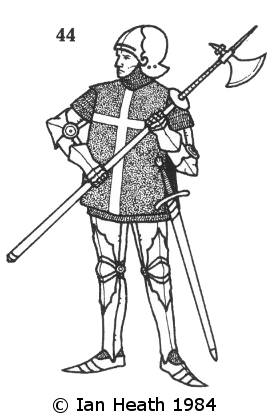
Try Amazon Fresh
KNIGHT HOSPITALLER, 1480
An extract from Armies of the Middle Ages, Volume 2by Ian Heath


|
44. KNIGHT HOSPITALLER, 1480
This figure is taken from the c.1490 ms. edition of the ‘Relation du Siege de Rhodes’ of William Caoursin, Vice-Chancellor of the Order at the time of the Ottoman siege of 1480. The sort of armour and tabard depicted had come into widespread use by the 1440s (compare, for example, with figure 12 in volume 1). It comprises a Milanese armour complete with arm and leg-harness and sallet, but without epaulières, pauldrons or tasses and with couters of only modest proportions (ie, a relatively light harness ideal for foot rather than mounted combat). It is apparent from several sources that on shipboard even lighter armour was worn, the leg-harness at least and possibly the arm-harness too probably being abandoned for ease of movement, as was sometimes also done in the defence of castle walls (Grand Master Pierre d’Aubusson himself suffering leg-wounds during the defence of Rhodes). Several such Rhodian armours as that depicted here were brought back to England from Turkey in the mid-19th century.
According to some the Grand Master’s own armour in 1480 was gilt, but the only indication of this in the Caoursin ms. is a dagged, gilt edging to his mail corselet. Indeed, d’Aubusson had himself put a stop to the use of decorated, inlaid armour and silk brigandines amongst the brethren of the Order (a trend which had been on the increase ever since the late-13th century), so it is highly unlikely that his own equipment would have been particularly ostentatious. One indulgence which he and other senior officers did permit themselves, however, was the use of their own family arms on their shields as explained on page 197. Other brethren carried shields bearing just the Order’s arms, some of which can be found in Caoursin’s mss., where shields are almond types extremely uncommon by this late date. Others in the same source are blue with linear decoration in yellow, and though most are held by men who are clearly non-brethren some at least are shown held by men wearing the Order’s cross-embroidered tabard.
The tabard, inevitably red with a white cross front and back, was called a supraveste. It was the Order’s official battle-dress, and was worn by its knights, serving brethren and donats alike, either loose as here or drawn tight at the waist by points tied at either side. Caoursin’s pictures show non-brethren wearing tabards of identical style, but usually dark blue or some other colour and heavily embroidered, some of them with inscriptions (like ‘S.Iohan’) to denote their allegiance to the Order. The woodcuts of the Ulm edition of Caoursin’s chronicle, printed in 1496, do not show brethren in tabards at all; instead they have a small cross painted in the middle of their breast and back-plates, possibly in red or some other dark colour in order to show up against the armour.
Weapons depicted in the ms. comprise sword, lance, pole-axe, crossbow and longbow. Handguns are also in evidence, mostly, but not entirely, in the hands of men not wearing the Order’s supraveste, which would suggest that most of the Hospitallers’ handgunners were hired specialists, which seems quite likely.